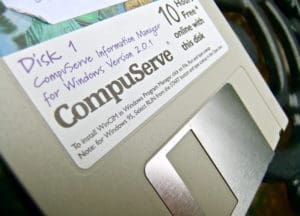 “Last night we … had a party for 11 people in nine different states and only had to wash one glass.”
“Last night we … had a party for 11 people in nine different states and only had to wash one glass.”
This isn’t a description of a Zoom happy hour. It’s the tagline of a 1983 magazine ad for CompuServe, the first online service available to consumers, which made its debut Sept. 24, 1979. Originally known as MicroNET, the service was sold through Radio Shack stores and ran on Tandy Model 100 computers.
The idea behind CompuServe was timesharing. Golden United Life Insurance had invested in mainframe computers—but those computers sat idle outside of business hours. In 1969, the company began allowing other businesses to purchase time on its mainframe, and 10 years later the program was expanded to a consumer audience. On July 1, 1980, MicroNET was rebranded as CompuServe.
Using CompuServe was pricey
An hour of non-peak service was $5, plus the cost of the phone call through your modem. Still, users enjoyed the access CompuServe provided to the outside world: the ability to purchase airplane tickets, check the stock market and even read online newspapers, including the San Francisco Examiner, as seen in this 1981 KRON news story. (The cost of downloading an issue was hefty; it took two hours to download a newspaper.)
CompuServe also provided email, with each user identified as seven to 10 octal digits separated by a comma (e.g., 12345,012). Another popular feature was the “CB Simulator,” a 40-channel online chat system so popular it consumed 20 percent of CompuServe users’ time on the service.
CompuServe dominated the consumer online market until the introduction of AOL in the mid-1990s. AOL actually purchased the service in 1998, and by the time CompuServe was shuttered in 2009, consumers had moved past the type of closed, proprietary online access these two options represented.
Photo: James Cridland via Flickr. Used under CC 2.0 License.
